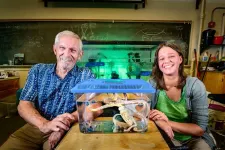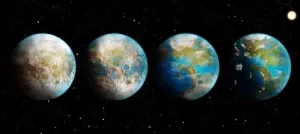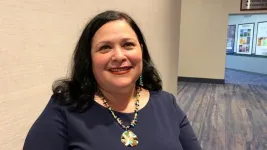(Press-News.org) Fertilizers manufactured from the sludgy leftovers of wastewater treatment processes can contain traces of potentially hazardous organic chemicals, according to a new study by Johns Hopkins University researchers.
The research, published today in Environmental Science & Technology journal, provides one of the most comprehensive looks at the chemical composition of so-called biosolids across the country and is the first step toward identifying common chemical contaminants that may need government regulation. The findings could help the U.S. Environmental Protection Agency prioritize which organic compounds to investigate further, the researchers said.
“We’ve been relatively in the dark when it comes to possible organic hazards in biosolids, and we need to know if there are any smoking guns that we’re unaware of,” said Carsten Prasse, an assistant professor in the Department of Environmental Health and Engineering who studies environmental contaminants. “Regulators need to know what these types of fertilizers are made of to determine how they can be responsibly used.”
Using analytical chemistry techniques capable of identifying thousands of chemicals, Prasse and his team screened 16 samples of biosolids from wastewater treatment facilities in nine U.S. and three Canadian cities. Samples contained traces of pharmaceuticals, industrial chemicals, and a variety of fragrances. Among them were bisphenol A (BPA), commonly found in plastics, and carbamazepine, a drug used to treat epilepsy and bipolar disorder.
“Because there are so many compounds in biosolids, the question we had was how do we triage? How do we find the chemicals that are widespread and could potentially be problematic, that the EPA and other scientists would need to investigate before proposing regulations,” Prasse said.
The researchers then created lists of the chemicals found in each sample and compared them to compounds that popped up in multiple places across the country. They identified 92 compounds that were present in 80% or more of the samples.
The researchers then cross-referenced those 92 compounds against the EPA’s CompTox Chemical Dashboard—a database that details the properties, hazards, and potential risks of thousands of chemicals. The dashboard helped the team identify which chemicals were most likely to pose threats to human health or the environment.
“We’re not saying that these compounds pose a risk right now, because we haven’t done a formal risk assessment,” said Matthew Newmeyer, a research associate at the Bloomberg School of Public Health and first author on the paper. “We’re saying that these have a potential to be problematic and we need more information in order to make sure these biosolids are safe.”
Using biosolids can be beneficial, the researchers said. They are rich in nitrogen, phosphorus, and other nutrients that help plants grow. They require less energy to make than synthetic alternatives. And wastewater facilities can sell biosolids to generate revenue to offset treatment costs and reduce waste sent to landfills or incinerators.
More than half of the 3.76 million tons of biosolids produced in the United States in 2022 fertilized agricultural lands, golf courses, and other landscaped areas, according to the EPA. While direct contact with biosolids is likely limited to occupational exposures, the broader population could be exposed to contaminants absorbed by crops grown in such fertilizers, the researchers said.
The team plans to measure the identified compounds in the biosolids and vegetables grown in biosolid-amended soil to determine if their concentration levels warrant concern. The researchers are also investigating risks to farmers, landscapers, and composters who work with biosolids.
END
Team aims to improve safety of fertilizers made from wastewater sludge
Johns Hopkins researchers create new list of possibly toxic contaminants commonly found in biosolids nation-wide
2024-06-25
ELSE PRESS RELEASES FROM THIS DATE:
From 'CyberSlug' to 'CyberOctopus': New AI explores, remembers, seeks novelty, overcomes obstacles
2024-06-25
CHAMPAIGN, Ill. — By giving artificial intelligence simple associative learning rules based on the brain circuits that allow a sea slug to forage — and augmenting it with better episodic memory, like that of an octopus — scientists have built an AI that can navigate new environments, seek rewards, map landmarks and overcome obstacles.
Reported in the journal Neurocomputing, the new approach gives AI the ability to explore and gather the information it needs to expand its spatial and temporal awareness, growing its knowledge base while learning on the job, said Ekaterina Gribkova, a postdoctoral researcher at the University of Illinois Urbana-Champaign who ...
The evolution of firefly lights
2024-06-25
The leading hypothesis for the origin of firefly lights has been overturned by a genomic analysis. It had been posited that the bright lights emitted by many species in the Lampyridae family of beetles—better known as fireflies—first evolved as a warning signal to predators, advertising the toxicity of fireflies, and were then repurposed as a mating signal. This explanation would account for why eggs, larvae, and pupae also glow. Ying Zhen and colleagues put the conventional wisdom to the test by compiling a family tree of fireflies and tracing the evolution of the chemical compounds ...
ASAP launches data-sharing tool with unique dataset of human postmortem-derived brain samples
2024-06-25
ASAP Launches Data-Sharing Tool with Unique Dataset of Human Postmortem-Derived Brain Samples
Aligning Science Across Parkinson’s (ASAP) launched a platform to make high-value data for Parkinson’s disease broadly available to researchers all over the world
The platform launches with data from a unique human postmortem-derived brain sequencing collection, including samples from four ASAP Collaborative Research Network (CRN) teams and 156 donors
The database will continue to expand, with 629 donors contributing to the final harmonized dataset; there will be a consistent cadence of new ...
Moving objects precisely with sound
2024-06-25
In 2018, Arthur Ashkin won the Nobel Prize in Physics for inventing optical tweezers: laser beams that can be used to manipulate microscopic particles. While useful for many biological applications, optical tweezers require extremely controlled, static conditions to work properly.
“Optical tweezers work by creating a light ‘hotspot’ to trap particles, like a ball falling into a hole. But if there are other objects in the vicinity, this hole is difficult to create and move around,” says Romain Fleury, head of the Laboratory of Wave Engineering in EPFL’s School ...
Sustainable electrification: Managing resource demands for future electric vehicles
2024-06-25
With goals to limit CO2 emissions, many countries have set targets to phase out internal combustion vehicles in favor of electric vehicles (EVs). Japan has set a target for 20-30% of all car sales to be battery electric vehicles (BEVs) and plug-in hybrid electric vehicles (PHEVs), and 30-40% of car sales to be hybrid electric vehicles (HEVs) by 2030. The USA plans for 50% of new vehicles to be zero-emission by 2030, while Germany wants to have 15 million EVs on the road by 2030. These goals raise concerns about the raw material demand for EVs. Batteries, which account for 50% of all resources consumed in BEV production, require ...
New AI program from BU researchers could predict likelihood of Alzheimer’s disease
2024-06-25
Trying to figure out whether someone has Alzheimer’s disease usually involves a battery of assessments—interviews, brain imaging, blood and cerebrospinal fluid tests. But, by then, it’s probably already too late: memories have started slipping away, long established personality traits have begun subtly shifting. If caught early, new pioneering treatments can slow the disease’s remorseless progression, but there’s no surefire way to predict who will develop the dementia associated with Alzheimer’s.
Now, Boston University researchers say they have designed a promising new artificial ...
Telltale greenhouse gases could signal alien activity
2024-06-25
If aliens modified a planet in their solar system to make it warmer, we’d be able to tell. A new UC Riverside study identifies the artificial greenhouse gases that would be giveaways of a terraformed planet.
A terraformed planet has been artificially made hospitable for life. The gases described in the study would be detectable even at relatively low concentrations in the atmospheres of planets outside our solar system using existing technology. This could include the James Webb Space Telescope, or a future European-led space telescope concept.
And ...
New study unveils formation secrets of tiny rare earth elements
2024-06-25
Researchers from Trinity College Dublin’s School of Natural Sciences have revealed a novel route to the formation of bastnäsite, a crucial mineral for the extraction of rare earth elements (REEs). Their work offers promise in one day making the extraction of these REEs more efficient.
The study – published today in the journal Nanoscale – uncovers for first time how fluocerite, a rare mineral, quickly forms and transforms into bastnäsite. The occurrence and origin of fluocerite in natural deposits was not fully understood, ...
DOE awards Sandia small business program and local veteran
2024-06-25
ALBUQUERQUE, N.M. — The Department of Energy has once again awarded Sandia National Laboratories for its work helping small businesses. One of those businesses, owned by a disabled veteran, was also awarded for its extraordinary work.
DOE Mentor of the Year
Sandia’s small business Mentor-Protégé Program has been named as DOE Mentor of the year, an award it has received for three consecutive years.
Now in its fifth year, the program has mentored five protégés from around the country. More than 150 volunteer mentors and support personnel help these small and disadvantaged businesses grow, succeed and navigate doing business ...
Family, friends can be more effective health role models than celebrities
2024-06-25
PULLMAN, Wash. – Your mom might be a better health influencer than Dwayne “The Rock” Johnson.
Adults in a study who said they looked to a person they knew as role model for good health—such as a friend, relative or healthcare provider—rather than a celebrity, had greater motivation to reach their health goals. The women participants were also more likely than men to choose a personal role model rather than a celebrity. And the person most often named was their own mother.
“We know that parents have a huge influence on shaping people’s health trajectories throughout their life just ...
LAST 30 PRESS RELEASES:
Longest observation of an active solar region
Why nail-biting, procrastination and other self-sabotaging behaviors are rooted in survival instincts
Regional variations in mechanical properties of porcine leptomeninges
Artificial empathy in therapy and healthcare: advancements in interpersonal interaction technologies
Why some brains switch gears more efficiently than others
UVA’s Jundong Li wins ICDM’S 2025 Tao Li Award for data mining, machine learning
UVA’s low-power, high-performance computer power player Mircea Stan earns National Academy of Inventors fellowship
Not playing by the rules: USU researcher explores filamentous algae dynamics in rivers
Do our body clocks influence our risk of dementia?
Anthropologists offer new evidence of bipedalism in long-debated fossil discovery
Safer receipt paper from wood
Dosage-sensitive genes suggest no whole-genome duplications in ancestral angiosperm
First ancient human herpesvirus genomes document their deep history with humans
Why Some Bacteria Survive Antibiotics and How to Stop Them - New study reveals that bacteria can survive antibiotic treatment through two fundamentally different “shutdown modes”
UCLA study links scar healing to dangerous placenta condition
CHANGE-seq-BE finds off-target changes in the genome from base editors
The Journal of Nuclear Medicine Ahead-of-Print Tip Sheet: January 2, 2026
Delayed or absent first dose of measles, mumps, and rubella vaccination
Trends in US preterm birth rates by household income and race and ethnicity
Study identifies potential biomarker linked to progression and brain inflammation in multiple sclerosis
Many mothers in Norway do not show up for postnatal check-ups
Researchers want to find out why quick clay is so unstable
Superradiant spins show teamwork at the quantum scale
Cleveland Clinic Research links tumor bacteria to immunotherapy resistance in head and neck cancer
First Editorial of 2026: Resisting AI slop
Joint ground- and space-based observations reveal Saturn-mass rogue planet
Inheritable genetic variant offers protection against blood cancer risk and progression
Pigs settled Pacific islands alongside early human voyagers
A Coral reef’s daily pulse reshapes microbes in surrounding waters
EAST Tokamak experiments exceed plasma density limit, offering new approach to fusion ignition
[Press-News.org] Team aims to improve safety of fertilizers made from wastewater sludgeJohns Hopkins researchers create new list of possibly toxic contaminants commonly found in biosolids nation-wide






